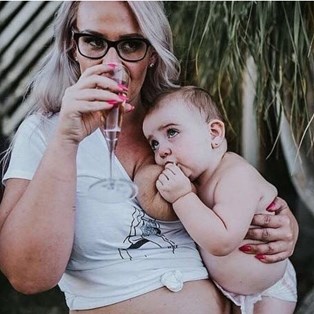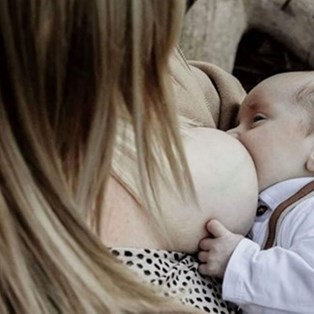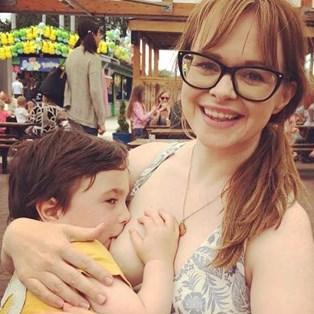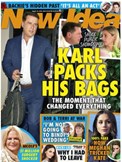When breastfeeding doesn't work out

It's important to know your options when stopping breastfeeding
By Ashlee Stirling
April 04 2023
Most mums in Australia start out breastfeeding. In fact, 96 per cent of them, according to statistics. But those same surveys also show a rapid decline in the number of women still exclusively offering their bubs the breast: less than half (39 per cent) of babies at three months, and less than a quarter (15 per cent) to five months.
Why are mums stopping? The biggest reasons for giving bub bottle feeds were: not enough milk (30 per cent), it was just time to stop (23 per cent), problems including cracked nipples (10 per cent) and going back to work (eight per cent).
Mums who find themselves weaning their babies from the breast often feel a deep sense of loss and failure.
“While this is a completely natural reaction, it is important to remember that you certainly have not failed and even if your baby received one drop of colostrum, you have provided your baby with a great start to life,” says Ashlee Stirling, a lactation consultant working in the babies’ ward at the Lady Cilento Children’s Hospital in Brisbane.
“Don’t feel concerned that because you aren’t breastfeeding, you have lost your opportunity to bond with your baby. You are still her main carer and your connection will be strengthened every time you respond to her needs.”
In her job, Ashlee talks to many mums about their options when finishing up with breastfeeding. Here are some choices to consider.
EXPRESSING MILK
Growing a baby from your own milk is an incredible feeling, but when your baby isn’t able to be fed directly from the source, there is an option to provide your breastmilk.
“If you are unable to breastfeed, exclusively expressing and feeding your baby your breastmilk is far superior than any other breastmilk alternative,” says Ashlee. The World Health Organization and UNICEF Global Strategy for Infant and Young Child Feeding states “the choice of the best alternative depends on individual circumstances”, but lists “expressed breast milk from an infant’s own mother” as number one.
Many mums are concerned they may find it harder to bond with their baby because they aren’t physically holding her to the breast, but there are ways around this. “By incorporating lots of skin-to-skin into your day and cuddles and interaction into feeding times, you can still retain the closeness felt when feeding your baby,”
“By incorporating lots of skin-to-skin into your day and cuddles and interaction into feeding times, you can still retain the closeness felt when feeding your baby,” says Ashlee. Talk to your local breastfeeding counsellor or lactation consultant about quality breast pump choices, or even consider hiring a hospital-grade pump, as it will likely get a good workout. Search online for exclusive pumping support groups – there are more of you around than you think!
Talk to your local breastfeeding counsellor or lactation consultant about quality breast pump choices, or even consider hiring a hospital-grade pump, as it will likely get a good workout. Search online for exclusive pumping support groups – there are more of you around than you think!
USING DONOR MILK
Talk of using another mother’s milk is making a resurgence, with more formal milk banks popping up worldwide, as well as a huge network of informal milk sharing between mothers, facilitated by the ever-expanding social media network. “As milk sharing is not without risks, it is important that mums are provided with enough information to make informed choices to help them choose the safest source of donor breastmilk,” says Ashlee.
“As milk sharing is not without risks, it is important that mums are provided with enough information to make informed choices to help them choose the safest source of donor breastmilk,” says Ashlee.
In Australia, there are five formal breastmilk banks, in WA, NSW, Victoria and Queensland, with many restrictions around who can access this milk.
“Milk banks are able to provide tested, pasteurised breastmilk to minimise risks of transmission of communicable diseases, but in Australia, these are few and far between,” says Ashlee. If you are considering donor milk obtained through the internet, you should be aware of the risks, including exposure to infectious diseases as the mother is unlikely to have been screened, and the possible contamination of milk if it’s not handled and stored properly.
If you’re still considering it, Ashlee suggests interested mums contact Human Milk 4 Human Babies (www.hm4hb.net/), a not-for- profit, social media-run community promoting safe milk sharing by encouraging full disclosure and the formation of relationships between donor mums and recipients. In Australia, it is illegal to accept money for breastmilk.
USING FORMULA
The most common alternative to breastmilk is infant formula. For many mums, it is a difficult decision to switch from giving bubs their own milk to a commercially made product. For many mums, there is no choice, and at the end of the day your baby needs to be fed in order to thrive, and therefore you shouldn’t feel guilty.
“Once you have made the informed decision to formula-feed your baby, it is important that you are shown the correct way to prepare, handle and store formula in order to reduce the risk of passing an infection to your baby,” says Ashlee.
COMBINATION FEED
So breastfeeding isn’t working, but you’re not quite ready to give it up yet. “Breastfeeding doesn’t have to be ‘all or nothing’,” says Ashlee. “It’s very beneficial to breastfeed your baby or give her the expressed milk you have, along with donor breastmilk or formula. Research has shown that the immunological properties of breastmilk increase as supply decreases so even a small amount is invaluable.”
If supply is the issue, it’s even possible to combination feed until baby starts solids, and as the amount of food builds up, drop the bottles until you are only offering a few breastfeeds a day and solid food.
Other women find they relax when the pressure is off them to exclusively breastfeed, and their milk supply actually boosts up to their baby’s need as a result. To make combination feeding work to your best advantage, it’s good to talk to a lactation consultant, as there are techniques to stop problems like breast refusal as baby gets older.
RELACTATION
What if you give up and then change your mind? Despite what many people think, stopping breastfeeding isn’t irreversible, and if mums are wanting to rebuild their milk supply and have the right support networks, they can certainly relactate.
Ashlee advises mums interested in re-starting their milk supply to seek help from an International Board Certified Lactation Consultant, preferably one with experience in relactation to help work out a plan to meet your breastfeeding goals.
“The plan will generally include lots of time at the breast for baby if they are willing, or skin-to-skin, an expressing regime and herbal supplements as well as pharmacological medications to increase milk supply,” says Ashlee.
Relactation takes a lot of patience and perseverance, so seek out emotional support from family or friends, or look up your local Australian Breastfeeding Association group, which may be helpful in connecting you with a like-minded support network.













